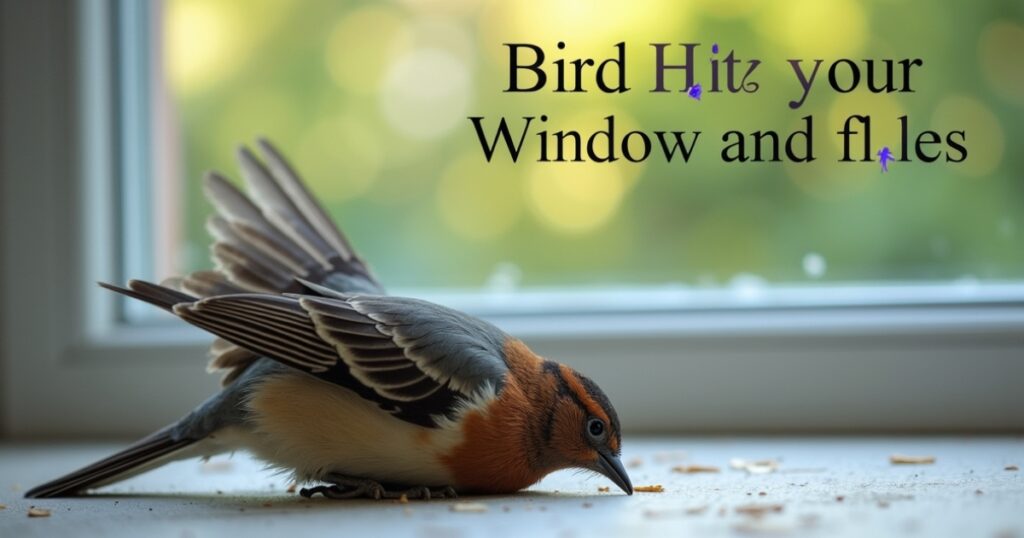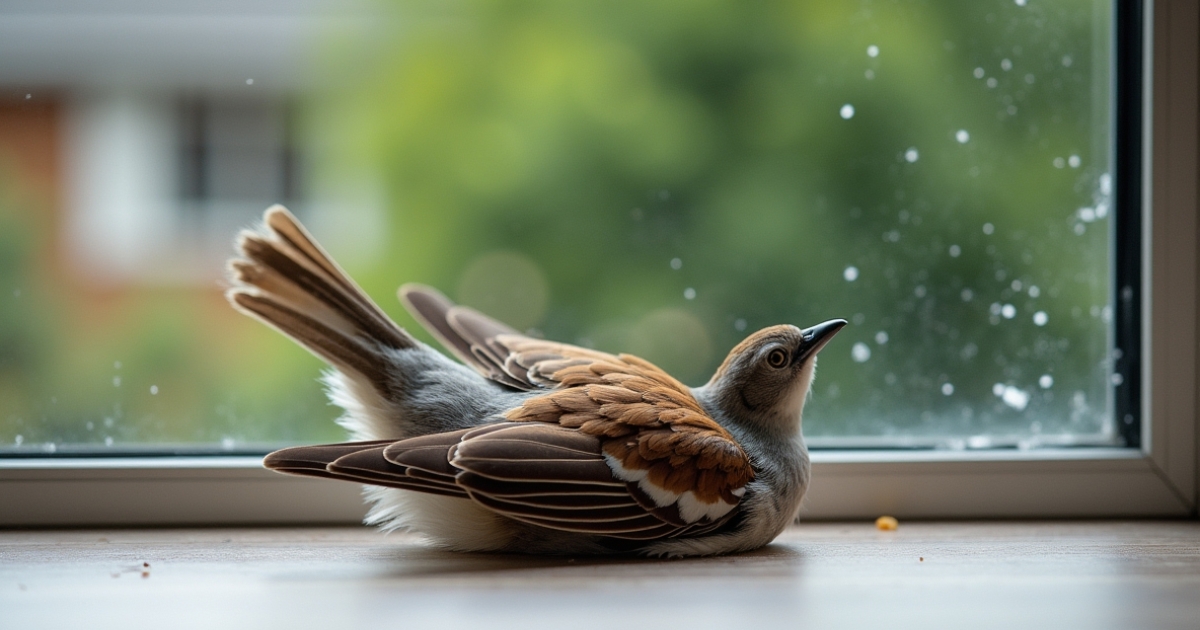Have you ever been startled by the sudden thud of a bird hitting your window, only to watch it shake itself off and fly away? This common yet unsettling experience often leaves us wondering about its significance.
Beyond the immediate concern for the bird’s welfare, many cultures throughout history have attached deeper meaning to these encounters.
In this comprehensive guide, we’ll explore both scientific explanations and spiritual interpretations of what does it mean when a bird hits your window and flies away.
The Science Behind Window Collisions
The first step to understanding bird window collisions is recognizing why they happen in the first place. These incidents aren’t random they result from specific behaviors and environmental factors.
Why Birds Collide With Windows
Birds crash into windows primarily because they can’t perceive glass as a barrier. Your windows reflect the surrounding environment trees, sky, clouds creating an illusion of continuous space that birds try to fly through.
Common scientific reasons include:
- Reflection confusion: Birds see reflections of habitat and try to fly into what they perceive as trees or sky
- Territorial defense: Some birds (especially during breeding season) attack their own reflection, thinking it’s a rival
- Night migration disorientation: Birds migrating at night can become confused by bright lights in buildings
- Direct line of flight: Birds don’t recognize windows when flying directly toward what they see beyond them
Most Common Window-Strike Species
Not all birds are equally likely to hit your windows. Research has found these species are most frequently involved in window collisions:
| Bird Type | Collision Rate | Seasonal Pattern |
|---|---|---|
| American Robin | Very High | Spring/Summer |
| Northern Cardinal | High | Year-round |
| European Starling | High | Winter/Spring |
| Mourning Dove | Moderate | Year-round |
| Cedar Waxwing | Moderate | Winter flocks |
| Hummingbirds | Moderate | Summer |
Seasonal Patterns
Bird window strikes follow predictable seasonal patterns:
- Spring/Summer: Increased territorial behavior and nesting activity
- Fall: Migration periods when unfamiliar birds pass through areas
- Winter: Fewer collisions overall, but increased activity around feeders
- Dawn/Dusk: Peak collision times when light conditions make windows most reflective
Understanding these patterns helps distinguish between accidental collisions and potentially meaningful visitations.
Cultural and Historical Perspectives
Long before modern science offered explanations, cultures worldwide developed rich traditions interpreting bird-window encounters.
Ancient Beliefs About Bird Messengers
Across civilizations, birds have been seen as messengers between human and spiritual realms:
- Ancient Egypt: Birds, especially falcons, represented divine messengers
- Greek mythology: Birds carried messages from gods to humans
- Celtic traditions: Birds were considered messengers from the Otherworld
- Mesopotamian cultures: Bird omens were carefully documented and interpreted
“Birds were thought to fly between worlds, carrying messages from the divine to the earthly realm.” Dr. Miranda Jenkins, Cultural Anthropologist
Native American Interpretations
Native American tribes hold bird flying into window meaning with particular significance:
- Lakota Sioux: Consider unexpected bird appearances as messages from ancestors
- Cherokee: See certain birds as spirit guides offering protection
- Hopi: Believe birds carry prayers to the Creator
- Ojibwe: Interpret bird encounters as signs of coming change
Many tribes believe that when a bird hits your window and flies away, it’s delivering a message that requires attention, not fear.
European Folklore Traditions
European folklore developed its own interpretations:
- Britain: A bird tapping on windows foretells death or major life changes
- German traditions: Birds trying to enter homes bring messages from departed loved ones
- Scandinavian lore: Birds at windows during winter represent souls seeking warmth
- Slavic beliefs: Certain birds bring fortune or misfortune depending on species and behavior
Eastern Cultural Perspectives
Eastern traditions offer additional insights:
- Chinese tradition: Birds represent freedom, happiness, and opportunity
- Japanese culture: Birds symbolize divine presence and communication
- Hindu interpretations: Different birds carry specific meanings (peacocks for wisdom, crows for ancestors)
- Buddhist perspective: Birds remind us of impermanence and the need for compassion
Spiritual Interpretations When Birds Survive
The fact that a bird flies away after hitting your window carries particular significance in spiritual interpretations.
The Significance of the Bird Flying Away
When asking “what does it mean when a bird hits your window and flies away,” many spiritual traditions suggest:
- Symbol of resilience: The bird’s ability to recover represents your own capacity to bounce back
- Transformation: The collision and flight away represents a transformative experience
- Wake-up call: A momentary disruption encouraging you to pay attention
- Message delivered: The bird completed its purpose by delivering its spiritual message
Many interpret the bird’s survival as a positive sign the message has been delivered without permanent harm.
Different Meanings Based on Bird Type
Different bird species carry unique symbolic meanings:
- Cardinals: Often associated with visits from departed loved ones
- Blue jays: Represent clarity, determination, and communicative power
- Sparrows: Symbolize simplicity, community, and self-worth
- Owls: Connected to wisdom, intuition, and seeing beyond illusions
- Crows/Ravens: Represent transformation, magic, and messages from the spirit world
- Doves: Symbolize peace, love, and new beginnings
What Repeated Visits Might Signify
When a bird keeps flying into window spiritual meaning takes on greater significance:
- Persistence of message: The spiritual realm really wants you to receive this message
- Intensification: The importance of the message is increasing
- Urgency: Something requires immediate attention
- Spiritual awakening: You’re experiencing heightened spiritual awareness
Pay attention to patterns same time of day, same window, same bird species as these may offer clues to the message’s meaning.
The Importance of Your Personal Reaction
Your emotional response provides valuable insight:
- Fear: You might be resisting an important life change
- Wonder/awe: You’re open to spiritual growth
- Curiosity: You’re being called to explore deeper questions
- Grief: You may be connecting with loss or transition

Window Collisions as Potential Messages
Many spiritual traditions interpret these events as communications with specific meanings.
Signs of Impending Change or Transition
When considering “what does it mean spiritually when a bird hits your window,” change is a common theme:
- Career transitions: New job opportunities or professional direction
- Relationship changes: Beginning or ending significant relationships
- Moving homes: Upcoming relocation or changes to your living situation
- Internal transformation: Personal growth or spiritual development
Warnings or Protective Messages
Some traditions interpret bird collisions as protective warnings:
- Pay attention to overlooked details: Something important needs your focus
- Reconsider current plans: A current path may need adjustment
- Health concerns: Taking better care of yourself or loved ones
- Environmental awareness: Becoming more conscious of your surroundings
Visitations from Departed Loved Ones
One of the most comforting interpretations involves departed loved ones:
- Anniversary connections: Birds appearing near significant dates
- Familiar patterns: Birds behaving in ways that remind you of someone
- Emotional resonance: Strong feelings of connection when the bird appears
- Repeated visits: Consistent appearances that seem intentional
Many people report feeling an immediate sense of connection with loved ones who have passed when birds interact with their windows.
Signals to Pay Attention to Overlooked Aspects of Life
Bird collisions often occur during moments of distraction or routine:
- Work/life balance: Reminders to address imbalances
- Neglected relationships: Calls to reconnect with important people
- Creative expression: Inspiration to pursue artistic endeavors
- Spiritual practice: Encouragement to deepen meditation or prayer
Taking Practical Action
While spiritual meanings are important, practical responses matter too.
Making Windows Safer for Birds
Responsible action includes making your windows safer:
- Window decals: Place bird silhouettes or patterns on glass
- External screens: Install fine-mesh screens that eliminate reflections
- Tape patterns: Apply strips of tape in grid patterns
- Proper feeder placement: Position bird feeders either very close to windows (less than 3 feet) or far away (more than 30 feet)
Taking these steps honors the spiritual significance while showing compassion for birds.
How Helping Birds Aligns with Spiritual Respect
Many spiritual traditions emphasize:
- Stewardship: Caring for birds demonstrates respect for messages they might bring
- Karma/balance: Positive actions toward birds invite positive energy
- Gratitude: Appreciation for the message through protective action
- Connection: Deepening your relationship with nature and its messages
Balancing Practical and Spiritual Responses
A holistic approach includes:
- Immediate care: Check if the bird needs help
- Window protection: Take steps to prevent future collisions
- Reflection: Consider the potential meaning
- Journaling: Document the experience and your thoughts
- Action: Respond to any insights you receive
When to Seek Help for Injured Birds
If a bird appears injured after hitting your window:
- Observe first: Give the bird time to recover from the shock
- Provide shelter: Place the bird in a safe, dark box if it’s unable to fly
- Contact experts: Call local wildlife rehabilitation centers for guidance
- Avoid overhandling: Minimize stress by limiting contact
Interpreting Your Personal Experience
Personal context plays a crucial role in understanding bird-window encounters.
Questions to Ask Yourself
Consider these questions when reflecting on your experience:
- What was happening in your life when the bird appeared?
- Did you recognize the bird species, and does it have personal significance?
- What window did the bird hit, and what room does that window illuminate?
- What time of day did it occur, and does that time have meaning?
- What were you thinking about at the moment of impact?
Journaling Prompts to Explore the Meaning
Try these prompts to deepen your understanding:
- Describe the bird encounter in detail, including your emotional response
- Write about any changes or challenges you’re currently facing
- Reflect on any dreams you’ve had recently involving birds or flight
- Consider what message you might need to hear right now
- Explore connections between the bird species and your personal associations
How Your Intuition Plays a Role
Your intuitive response often contains valuable insight:
- First impressions: Your immediate thought may reveal subconscious understanding
- Recurring thoughts: Ideas that keep returning after the event
- Physical sensations: Goosebumps, warmth, or other bodily responses
- Emotional resonance: Strong feelings that arise during reflection
Trust these intuitive responses as part of the interpretive process.

Common Questions Answered
Let’s address the most frequently asked questions about bird-window encounters.
Differences Between Hitting, Tapping, and Perching
These distinct behaviors carry different meanings:
- Hitting and flying away: Often interpreted as a delivered message or wake-up call
- Deliberate tapping: Considered more intentional, possibly urgent communication
- Perching/watching: Suggesting observation, patience, or contemplation
- Singing at windows: Associated with messages of joy or important announcements
Interpreting Encounters Based on Time of Day
Timing adds another layer of meaning:
- Dawn: New beginnings, fresh opportunities, awakening consciousness
- Midday: Peak awareness, clarity, illumination of issues
- Dusk: Transition, reflection, completing cycles
- Night: Subconscious messages, dreams, hidden wisdom
Multiple Birds vs. Single Bird Visitations
The number of birds creates different interpretations:
- Single bird: Personal message or individual guidance
- Pair of birds: Relationship matters, partnership, balance
- Three birds: Creative expression, communication, manifestation
- Large flock: Community concerns, collective wisdom, broader social changes
What It Means When the Same Species Returns Repeatedly
Repeated visits from the same type of bird suggest:
- Intensification: The message is becoming more important
- Patience: The spiritual realm is waiting for your acknowledgment
- Learning process: You’re being taught something that requires repetition
- Confirmation: Validating that you’re on the right path
Birds in Dreams vs. Real-Life Encounters
Window collisions often connect with dream symbolism in meaningful ways.
Connecting Window Strikes with Bird Dream Symbolism
Consider these connections:
- Dreams of birds before window strikes: May be preparation for the waking message
- Dreams after window encounters: Often provide additional context or clarity
- Similar bird species in dreams and reality: Reinforcement of the same message
- Contrasting dream/reality experiences: Different aspects of the same teaching
How Waking Encounters Might Reinforce Dream Messages
When birds appear in both dreams and waking life:
- Note similarities in species, behavior, and your emotional response
- Consider the dream setting in relation to the window location
- Reflect on the timing between dream and waking encounters
- Look for repeated symbols or themes across both experiences
“The boundary between dreams and waking reality becomes permeable when birds appear in both realms. Pay special attention to these synchronicities.” Dr. Maria Sanchez, Dream Researcher
When to Pay Special Attention
Certain circumstances suggest heightened significance.
Unusual or Rare Bird Species Appearances
Encountering uncommon birds often carries special meaning:
- Outside their normal range: Extraordinary effort to deliver a message
- Endangered species: Precious or rare opportunity for communication
- Birds with distinctive colorations: Specific symbolic attributes
- Non-native species: Influences from unexpected sources
Timing Coincidences with Significant Life Events
When bird encounters align with important life moments:
- Birthdays/anniversaries: Connections with personal cycles and milestones
- Major decisions: Guidance during choice points
- Health challenges: Support during difficult periods
- Career changes: Direction during professional transitions
These synchronicities suggest deliberate timing rather than random chance.
Multiple Witnesses to the Same Event
When others share your experience:
- Shared message: The communication may be relevant to multiple people
- Validation: Confirmation that the event has objective significance
- Community impact: The message may affect group dynamics
- Different perspectives: Each witness may receive a personalized aspect of the message
Your Emotional Response as a Clue to Meaning
Strong emotions often indicate significance:
- Overwhelming emotion: The message touches something fundamental
- Unusual calm: Perhaps indicating divine reassurance
- Persistent thoughts: Your mind trying to process the meaning
- Synchronistic thoughts: Thinking about someone just before the bird appears
Conclusion
When asking “what does it mean spiritually when a bird hits your window and dies” versus one that flies away, we often find more hope in the latter. A bird that survives and continues its journey suggests resilience, transformation, and successful message delivery.
Remember that these encounters exist at the intersection of scientific understanding and spiritual interpretation. The bird’s collision has physical explanations involving reflection and bird behavior, while simultaneously carrying potential symbolic meaning unique to your circumstances.
The most meaningful interpretation combines:
- Cultural and historical context
- Scientific understanding of bird behavior
- Your personal circumstances and intuition
- The specific details of the encounter (species, timing, behavior)
By honoring both the physical bird and any spiritual message it might carry, you create space for insight while maintaining practical compassion.









